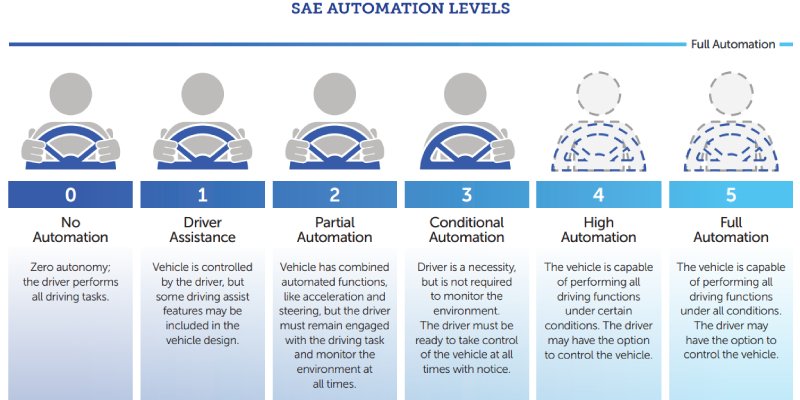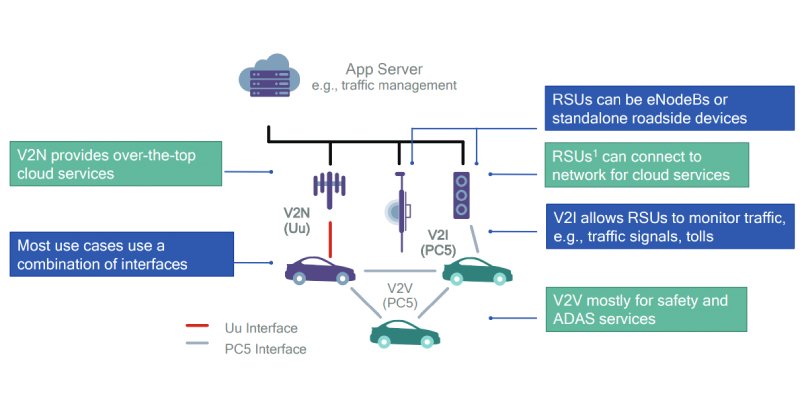
With increasing amounts of automation, the transport systems become more connected, integrated, and intelligent in handling complex combinations of situations to create an improved experience for people. The vehicles themselves have been in a state of transformation with more intelligence within the vehicle\
Most of us may have encountered some form of automation and intelligence in the traffic management systems in our daily lives. One such example may be a visible counter at a traffic signal light. A slightly more advanced example could be traffic signals that modify their timers based on situations; time-of-day (e.g., yellow blinking lights at night) or traffic intensity (e.g., longer green light in the direction of heavy traffic). A further advanced example could be digital speed limit signages on a highway that may modify the limit based on situation (e.g., weather conditions, road repair work).
What is ITS?
The ITU-R handbook on Land Mobile defines ITS as “systems utilizing the combination of computers, communications, positioning and automation technologies to improve the safety, management and efficiency of terrestrial transportation”. The handbook notes that there has been an increasing trend in motorization, urbanization, and population in the world for several decades causing traffic congestion, safety issues and air pollution. ITS supports a toolset to help mitigate and possibly reduce traffic congestion and incidents using wireless communications, sensors technologies computer and control technologies, and widespread information dissemination.
The handbook also lists three major groups for ITS systems:
- The road operators who manage roads efficiently, monitors the road situation and provide information to road users;
- The vehicle drivers who go to their destination without accidents;
- Travelers or pedestrians who need traffic information or emergency assistance

The perspective of different user groups can be used to explain the ITS service.
Road operator: this is the entity that manages roadways to meet local objectives. Generally, this may mean maintenance of traffic flows and responding to safety incidents. The road operator may need to monitor the road situation and provide information to the road users. This road operator plays a significant role in most ITS services. This user group represents the critical infrastructure side of an ITS network.
Vehicle Drivers: this is the second user group that is composed of vehicle drivers. The main objective of this group is to reach their destination without accidents, and efficiently. This is the group of users in a typical system that constitutes the end-users of the ITS service. This group of users also indirectly become the source of much of performance data of the roads. The data may be collected via remote sensing, or actively gathered by the vehicle and provided via a third-party.
Travelers or Pedestrians: this is the third user group that uses ITS services. These users may utilize ITS to get traffic information, plan their travel, use the transit services or request emergency assistance.
Objectives of ITS system
For different regions to benefit from ITS, they may consider different objectives. Broadly the objectives may be categorized into five main areas:
- Safety (e.g., Forward Collision Warning, Blind Spot/Lane Change Warning, Emergency Electronic Brake Lights)
- Mobility (e.g., Signal Priority, Emergency Vehicle Preemption, Cooperative adaptive cruise control)
- Environmental (e.g., Dynamic Eco-routing – light vehicle / transit / freight, Low Emission zone management)
- Regulatory (e.g., Vehicle classification, tolls)
- Convenience (e.g., Ride-share, parking)

Driving Automation
The SAE J3016, Recommended Practice: Taxonomy and Definitions for Terms Related to Driving Automation Systems for On-Road Motor Vehicles, commonly referenced as the SAE Levels of Driving Automation, has been the most-cited industry source for driving automation. The SAE’s six levels of driving automation provide a taxonomy with detailed definitions of driving automation, ranging from from Level 0 (no driving automation) to Level 5 (full driving automation) in the context of motor vehicles and their operation on roadways by describing the driving automation systems.
The National Highway Traffic Safety Administration (NHTSA) under the US Department of Transportation adopted the SAE automation levels in their vision for safety publication .
Emergence of connected automated driving
While the overall transport systems have been improving, the vehicles themselves have been in a state of transformation with more intelligence within the vehicle. Connected vehicles are also becoming more prevalent. The NHTSA and the European Road Transport Research Advisory Council (ERTRAC) recognize that automated driving is a strong force towards improved experience for road users. The NHTSA page on Automated Vehicles for Safety and the ERTRAC roadmap on Connected Automated Driving Roadmap list that the main drivers for higher levels of Automated Driving are:
- Safety: Reduce accidents caused by human errors.
- Efficiency and environmental objectives: Increase transport system efficiency and reduce time in congested traffic by new urban mobility solutions. Also, smoother traffic will help to decrease the energy consumption and emissions of the vehicles.
- Comfort: Enable user’s freedom for other activities when automated systems are active.
- Social inclusion: Ensure mobility for all, including elderly and impaired users.
- Accessibility: Facilitate access to city centres.

Roadmap for ITS in different regions
There has been an increased emphasis on supporting and adopting new emerging technologies for enhancing safety, efficiency, and accessibility of transportation.
The US Department of Transportation, through the Intelligent Transportation Systems Joint Program Office published its Strategic Plan 2020-2025 towards encouraging adoption of next generation technologies for improving access and mobility, and increasing economic productivity.
China Intelligent and Connected Vehicles (CICV) also recently announced the establishment of International Communication and Cooperation Committee of ICV roadmaps.
Japan has a Cross-ministerial Strategic Innovation Promotion Program (SIP) for Innovation of Automated Driving for Universal Services (SIP-adus) aiming to solve issues of concern in today’s society through realizing automated driving, including reducing traffic accidents, alleviating traffic congestion and securing a means of transportation for people with limited mobility, such as the elderly living in remote regions, among other issues. This programme started in Fiscal Year 2014 and entered its 2nd Phase in Fiscal Year 2018. In the second phace, the scope has been extended to include automated driving on general public roads and application to logistics and transportation services.
Korea’s Ministry of Land, Infrastructure and Transport (MOLIT) has a long-term plan to deploy C-ITS applications in Korea. ITS Korea is recognized by MOLIT as the designated national organization for ITS Standards, verification, performance evaluation, international cooperation and overseeing pre-deployment of C-ITS.
C-V2X Technology and Use-Cases
Designed specifically for transportation, 3GPP cellular-vehicle-to-everything (C-V2X) technology supports direct, low-latency communication between vehicles (V2V), roadside infrastructure (V2I), and vulnerable road users (VRUs) such as pedestrians (V2P) to inform safety-critical and mobility-enhancing applications. When complemented by cellular networks (V2N), C-V2X makes transportation systems and the entire ecosystem more efficient. When vehicles are connected to everything around them, road users and infrastructure can coordinate their actions to make travel safer —reducing crashes, injuries, and fatalities on roadways. Because crashes and other non-recurring incidents account for approximately half of traffic congestion in many parts of the world, enhancing safety also helps to improve mobility which directly correlates to sustainability .
3GPP Release 14 based C-V2X establishes the foundation for V2X communication for basic safety messages exchange. Release 15, 3GPP release, incorporates additional features like Transmit Diversity and 10 ms PDB (Packet Delay budget) which bring improved range and reliability. The 5G NR C-V2X, based on the next 3GPP Release 16 standard, will usher in a new era of much higher throughput, much higher reliability, lower latencies, and opening possibilities of newer use cases.
Roadmap of C-V2X Use-cases
5G Automotive Association (5GAA) published its Visionary Roadmap for Advanced Driving Use Cases, Connectivity Technologies and Radio Spectrum Needs . This roadmap carries the results of its studies relating to the evolution of automotive connectivity for the purposes of enhanced road safety, improved traffic efficiency, greener environmental impact, and more comfortable driving.
Many so-called day-1 basic safety use cases have been widely analysed in the past, and several of these have already been deployed. This white paper focuses on advanced driving use cases which pave the way to automated driving, and thereby contribute to global safety and traffic efficiency goals, as well as environmental benefits for citizens and consumers.
5GAA has identified the most promising advanced driving use cases such as Cooperative Manoeuvres and Sensor Sharing, in conjunction with the adoption of Cellular Vehicle-To-Everything (C-V2X) standards as well as availability of required technologies and devices, i.e. on-board units (OBUs), road-side units (RSUs), and smartphones, integrating the latest chipsets and modules. The market trajectory of the identified use cases is described along with the expected timeline for their mass market deployment.
The white paper also highlights the spectrum needs for basic and advanced driving use cases in the range of 70 MHz for direct communication in 5.9 GHz.
Towards the success of C-V2X in India
The success of ITS is critical to road-safety and reducing the carbon footprint in the country. For this, the compatibility / interoperability of all the vehicles on the road and the road-side infrastructure is an important consideration. Adoption of a harmonized technology option would have advantages of an evolved ecosystem avoiding and avoid major challenges in implementation. India has a natural advantage where no legacy V2X implementations exist, and we have a clean-slate to leap-frog and adopt the latest advancements in technology and accelerate our national deployments.
Department of Tele-communications, Govt. of India recently published its National Frequency Allocation Plan 2022 which enables the deployment of C-V2X in 5.9 GHz.
Ecosystem: The ecosystem that may get developed because of ITS implementation creates an opportunity to modernize the nation’s infrastructure by incorporating new and innovative transportation technologies. The state, regional and local traffic departments may consider how to incorporate connected vehicle technologies to achieve their infrastructure modernization goals.
National C-V2X deployment plan: To realize the full benefits of C-V2X, a cross-ministerial collaboration with public and private transportation industry stakeholders may develop and implement a national plan for C-V2X deployment. The plan should identify a clear roadmap for C-V2X deployments, including a reasonable timeline with deployment targets and benchmarks. Working together, government and industry can help realize the full safety benefits of C-V2X.
Dr Punit Rathod, Lead-Technical Standards, Qualcomm Standards & Industry Organizations
 TrafficInfraTech Magazine Linking People Places & Progress
TrafficInfraTech Magazine Linking People Places & Progress


